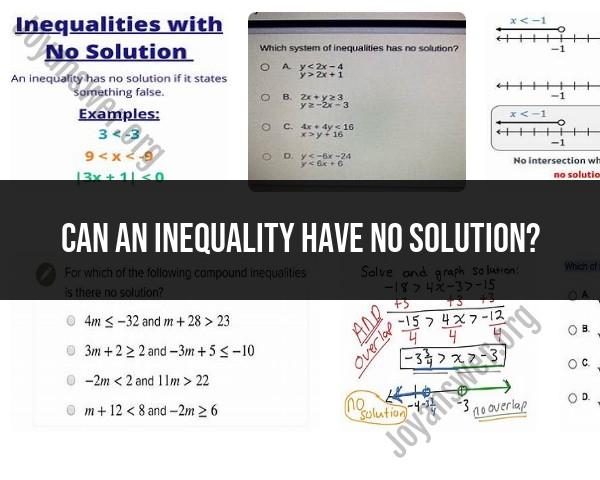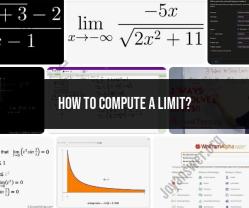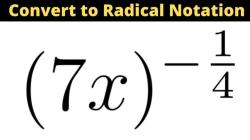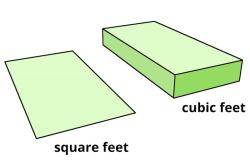Can an inequality have no solution?
Yes, inequalities can have no solution, and this occurs when there are no values that satisfy the given inequality. In mathematics, inequalities are expressions that compare two values or expressions, often using symbols like "<" (less than), ">" (greater than), "<=" (less than or equal to), or ">=" (greater than or equal to). The lack of a solution typically occurs for two main reasons:
Contradictory Inequalities: If you have a system of inequalities that are contradictory, it means they cannot be simultaneously true. For example, consider the following system of inequalities:
There is no real number that can satisfy both of these inequalities at the same time because they contradict each other. Therefore, this system of inequalities has no solution.
Empty Solution Set: In some cases, a single inequality may have no solution because the range of values that would satisfy it is empty. For example, consider the inequality:
There are no real numbers that are less than 1, so the solution set is empty, indicating that there are no values of that satisfy the inequality.
It's important to note that the existence of a solution or the lack thereof depends on the specific inequality or system of inequalities and the values involved. In many cases, inequalities do have solutions, and those solutions may be ranges of values rather than single, specific numbers. However, it is possible for inequalities to have no solution when the conditions or requirements set by the inequalities are not met by any values within the domain of consideration.
Exploring scenarios in which an inequality has no solution
An inequality has no solution when it produces a false statement for all possible values of the variable(s). This can happen when the inequality is inconsistent, meaning that it is impossible for both sides of the inequality to be true at the same time.
Understanding the mathematical conditions for unsolvable inequalities
There are two main mathematical conditions for unsolvable inequalities:
- Contradictions: A contradiction is a statement that is always false. For example, the statement "1 = 2" is a contradiction. Inequalities that produce contradictions have no solution.
- Empty sets: An empty set is a set that contains no elements. For example, the set of all negative even prime numbers is an empty set. Inequalities that produce empty sets have no solution.
Real-world examples and applications of inequalities without solutions
Here are some real-world examples and applications of inequalities without solutions:
- Economics: The following inequality is inconsistent and has no solution:
Price > Cost + Profit
This inequality states that the price of a product must be greater than the sum of its cost and profit. However, this is not always possible. For example, if the cost of a product is $10 and the desired profit is $5, then the price of the product cannot be less than $15.
- Geometry: The following inequality is inconsistent and has no solution:
Area of a triangle > Perimeter of a triangle
This inequality states that the area of a triangle must be greater than its perimeter. However, this is not always possible. For example, a square has the same area and perimeter, so this inequality would not be satisfied for a square.
- Physics: The following inequality is inconsistent and has no solution:
Velocity of light > Speed of sound
This inequality states that the velocity of light must be greater than the speed of sound. However, this is not always possible. In fact, the speed of sound is much slower than the velocity of light.
Strategies for identifying and addressing inconsistency in inequalities
One way to identify inconsistency in inequalities is to look for contradictions. If an inequality produces a statement that is always false, then the inequality is inconsistent and has no solution.
Another way to identify inconsistency in inequalities is to look for empty sets. If an inequality produces a set that contains no elements, then the inequality is inconsistent and has no solution.
Once an inconsistent inequality has been identified, it is important to address the inconsistency. This can be done by revising the inequality or by rephrasing the problem.
Implications of unsolvable inequalities in mathematics and beyond
Unsolvable inequalities can have a number of implications in mathematics and beyond. For example, unsolvable inequalities can be used to prove that certain theorems are false. Unsolvable inequalities can also be used to identify and avoid errors in mathematical proofs.
In addition, unsolvable inequalities can be used to model real-world situations that are impossible. This can be useful for understanding the limitations of mathematical models and for developing new models that are more accurate.
Overall, unsolvable inequalities are an important concept in mathematics with a wide range of applications.











